While SocialBu provides a useful API for social media automation, developers and agencies often encounter its limitations. The search for a more robust SocialBu API alternative is typically driven by the need for broader platform support, superior reliability, faster performance, and more flexible integration options. If you're building a social media application or scaling an agency's workflow, finding an API that seamlessly fits into your existing infrastructure is crucial.
This guide is your direct path to solving these challenges. We will analyze 12 powerful tools, each offering distinct advantages, from unified scheduling endpoints to advanced analytics and no-code automation. We'll start with our own solution, LATE, before exploring other top contenders like Publer, Sprout Social, and Buffer. Understanding how a modern AI solution integration with existing systems can enhance your stack is a key consideration when evaluating these platforms.
Forget generic feature lists. This resource provides a practical breakdown of each alternative's core strengths, ideal use cases, and honest limitations. Complete with screenshots and direct links, this article is designed to help you quickly identify and implement the perfect API for your project's specific needs.
1. LATE: The Unified API for High-Performance Social Scheduling
LATE emerges as a premier SocialBu API alternative for developers and agencies seeking a powerful, consolidated social media management backbone. It is engineered to simplify a complex ecosystem by unifying ten major social platforms, including emerging networks like Threads, TikTok, and Bluesky, into a single, high-performance REST API. This developer-first approach eliminates the engineering overhead of building and maintaining separate integrations for each network.
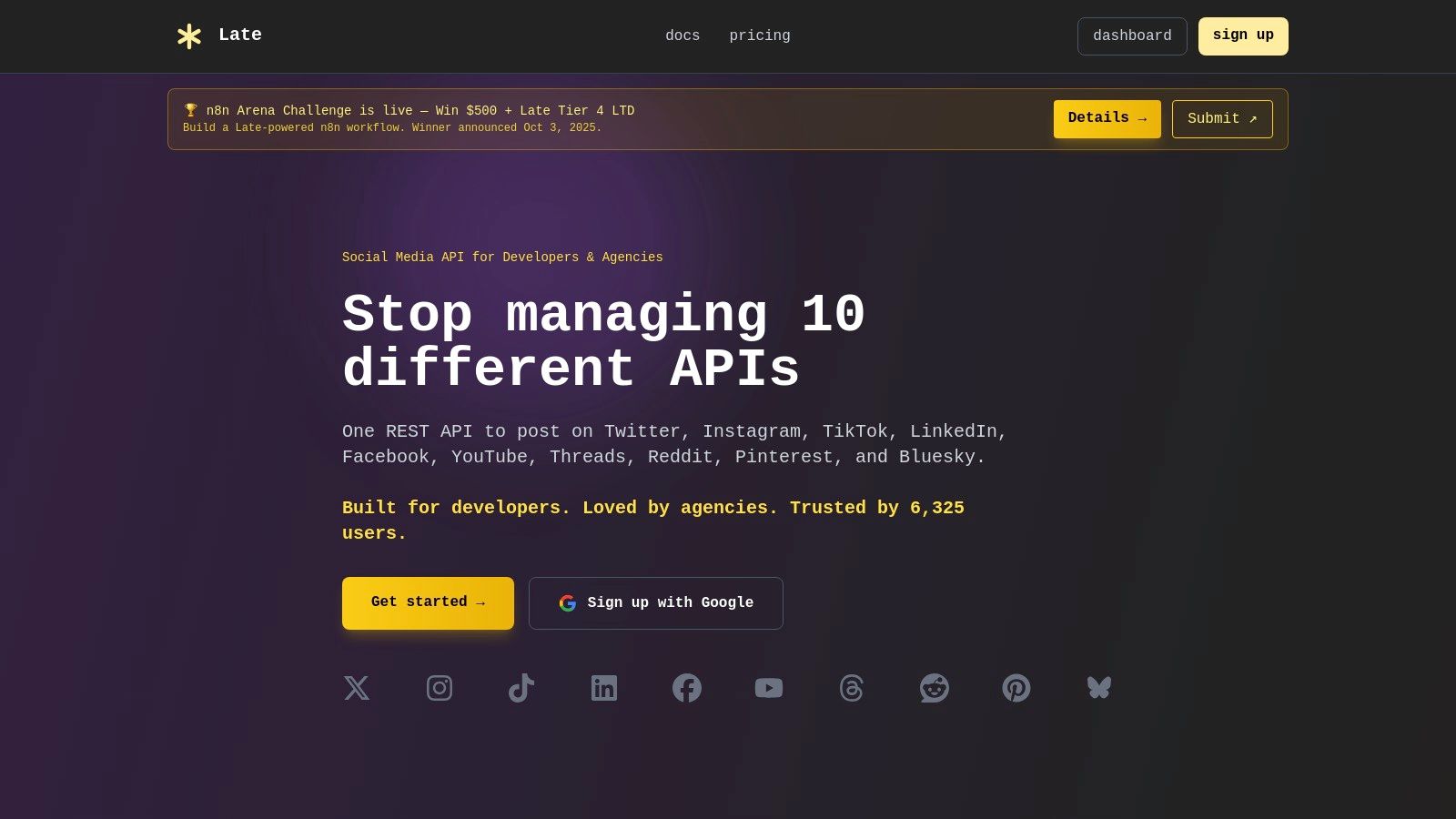
Key Capabilities and Use Cases
LATE is built for reliability at scale, boasting an impressive 99.97% uptime and sub-50ms API response times. This makes it ideal for SaaS products needing to embed robust social scheduling features or agencies managing high-volume client accounts.
For those without extensive development resources, LATE offers extensive no-code accessibility. It provides native integrations for Zapier, n8n, and Make, alongside a clean, intuitive dashboard for direct scheduling. This flexibility supports diverse workflows, from automated content pipelines for marketing teams to streamlined collaboration for agencies using its multi-client and white-label features.
Pros and Cons
- Pros:
- Unified API: A single REST endpoint covers 10 major social platforms.
- High Performance: Guarantees 99.97% uptime and sub-50ms response times.
- Flexible Workflows: Supports API calls, a no-code dashboard, and native Zapier/n8n/Make integrations.
- Agency-Ready: Includes multi-client management, team collaboration, and white-labeling.
- Cons:
- Tiered Feature Access: Unlimited posting and advanced features are reserved for higher-tier plans.
- Learning Curve: Leveraging the full API or complex n8n workflows may require technical familiarity.
Pricing and Access
LATE's pricing is designed for scalability, starting with a free plan for individuals. Paid tiers (Professional and Enterprise) unlock more accounts, higher posting limits, and advanced agency features, offering a cost-effective solution compared to many established competitors.
Website:https://getlate.dev
2. Publer
Publer presents itself as a comprehensive social media management platform, but for developers, it’s a powerful and accessible SocialBu API alternative. Its well-documented REST API allows for programmatic control over posts, media uploads, account management, and analytics retrieval. This makes it an excellent choice for agencies building custom client dashboards or developers integrating social media functionality directly into their own applications.
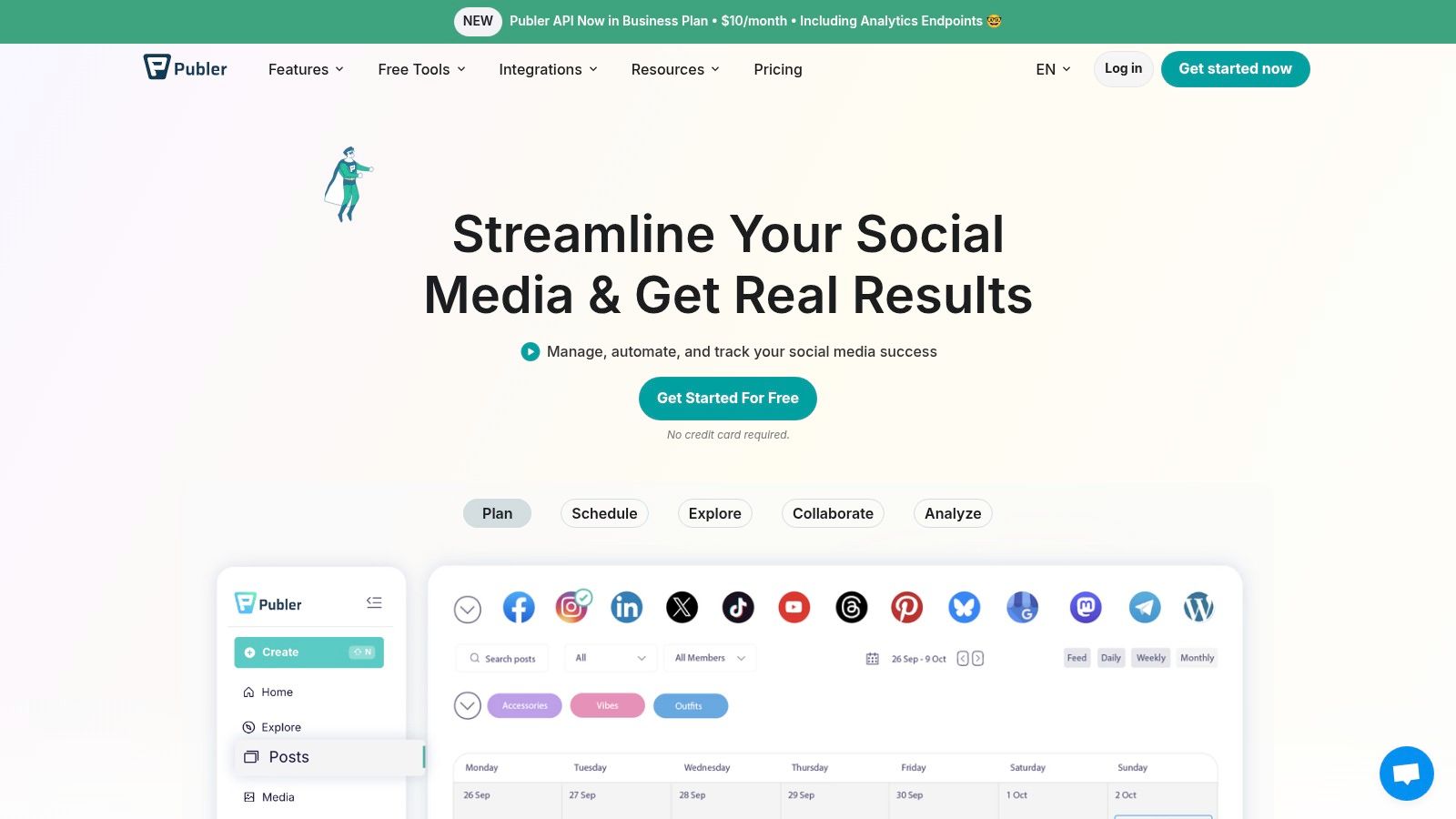
The API supports an extensive list of networks, including newcomers like Threads, Bluesky, and Mastodon, giving developers a future-proof toolset. Implementation is streamlined thanks to clear documentation and a ready-to-use Postman collection for quick testing.
Key Features & Considerations
Unlike some competitors that gate their API behind opaque enterprise agreements, Publer includes API access in its Business plan. This provides a clear, scalable path for growing teams that need both a robust UI for manual management and an API for automation. The API tokens are easy to generate and manage within the user interface.
- API Access: Included with the Business and Enterprise tiers.
- Network Support: Broad coverage including Facebook, Instagram, TikTok, LinkedIn, Pinterest, Threads, and more.
- Documentation: Clear quickstart guides and a full Postman collection.
- Limitations: API access is not available on the free or Professional plans, and lower-tier paid plans may have daily post limits.
For developers seeking an API with transparent pricing and wide channel support, Publer is a top-tier contender.
Website:https://publer.com
3. Sprout Social
Sprout Social is an enterprise-grade social suite that serves as a powerful SocialBu API alternative for organizations requiring robust analytics and programmatic publishing. Its Public API is designed for deep integration, allowing developers to pull owned profile data for business intelligence dashboards or build custom content publishing workflows directly into proprietary systems. This makes it a top choice for large brands and agencies with complex reporting and governance needs.
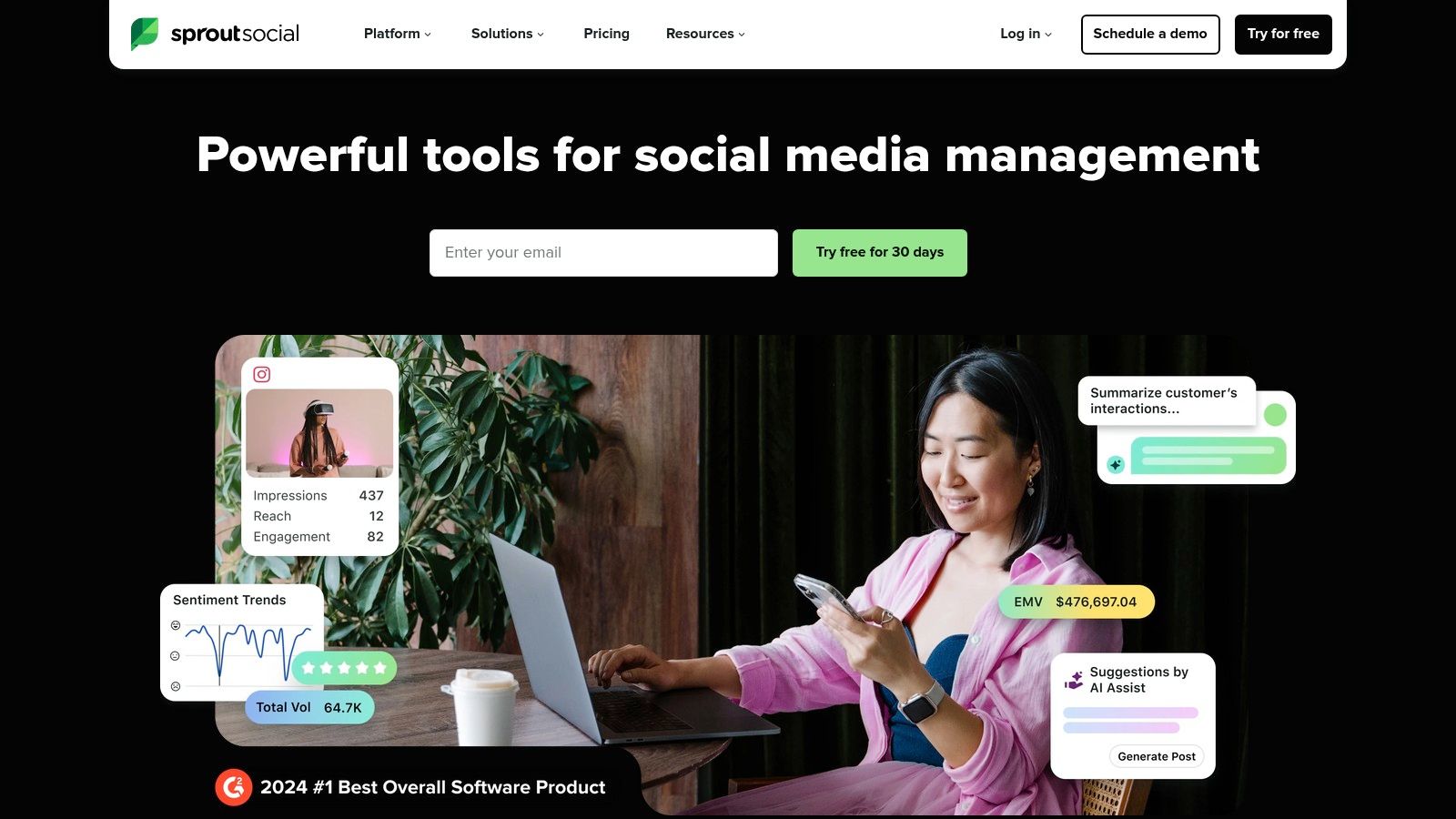
The API provides read endpoints for profile, post, and demographic data, alongside write endpoints for creating posts and uploading media. Authentication uses OAuth 2.0 or account-scoped tokens, ensuring secure and scalable access managed by platform administrators.
Key Features & Considerations
Unlike platforms offering API access on lower tiers, Sprout Social gates its API behind its Advanced plan and requires specific admin permissions to be enabled. This positions the API as a premium feature for businesses that need enterprise-level security, role-based access controls, and dedicated support. The analytics model is particularly strong, backed by excellent documentation.
- API Access: Available on the Advanced plan with explicit admin permissions.
- Network Support: Comprehensive support for major networks like Facebook, Instagram, Twitter, LinkedIn, and Pinterest.
- Documentation: Robust and well-supported documentation for a smooth developer experience.
- Limitations: The API is a significant investment and does not provide access to competitor or paid advertising data.
For teams needing a highly secure, scalable, and analytics-focused API, Sprout Social offers a market-leading solution.
Website:https://sproutsocial.com
4. Buffer
Buffer is a well-known name in social media scheduling, and its developer platform makes it a straightforward SocialBu API alternative for teams needing simple, programmatic posting. While its API is currently undergoing a significant rebuild, it provides core functionalities for managing post queues, retrieving profile information, and publishing updates. It's an excellent choice for developers who need to integrate basic social media automation into applications used by teams already familiar with Buffer's clean user interface.
The platform uses OAuth 2.0 for secure authorization and offers clear developer documentation and a portal for app registration. For those seeking no-code solutions, Buffer's extensive integration with platforms like Zapier provides a powerful alternative to direct API calls for building automated workflows.
Key Features & Considerations
Buffer’s API is accessible on all its paid plans, offering an affordable entry point for developers and small businesses. The company is transparent about its rate limits and provides a clear path for getting started. However, developers should be aware that the API is in a state of transition, with some newer features still in early access, which may affect long-term project planning.
- API Access: Available on all paid plans (Essentials, Team, Agency).
- Network Support: Core support for Instagram, Facebook, TikTok, LinkedIn, Mastodon, and Pinterest.
- Documentation: Developer portal with guides for OAuth and key endpoints.
- Limitations: The API is currently being rebuilt, so some endpoints might change or have limited functionality. Rate limits have historically been conservative.
For projects requiring simple, reliable scheduling automation backed by a trusted brand, Buffer's API is a solid and accessible option.
Website:https://buffer.com
5. Hootsuite
Hootsuite is an established, enterprise-focused social media platform that serves as a powerful SocialBu API alternative for large organizations. Its developer ecosystem is extensive, offering APIs and SDKs that extend beyond simple posting to include CRM integration, customer messaging via Sparkcentral APIs, and detailed metrics. This makes it ideal for enterprises that need to integrate social media data into broader business intelligence and customer service workflows.
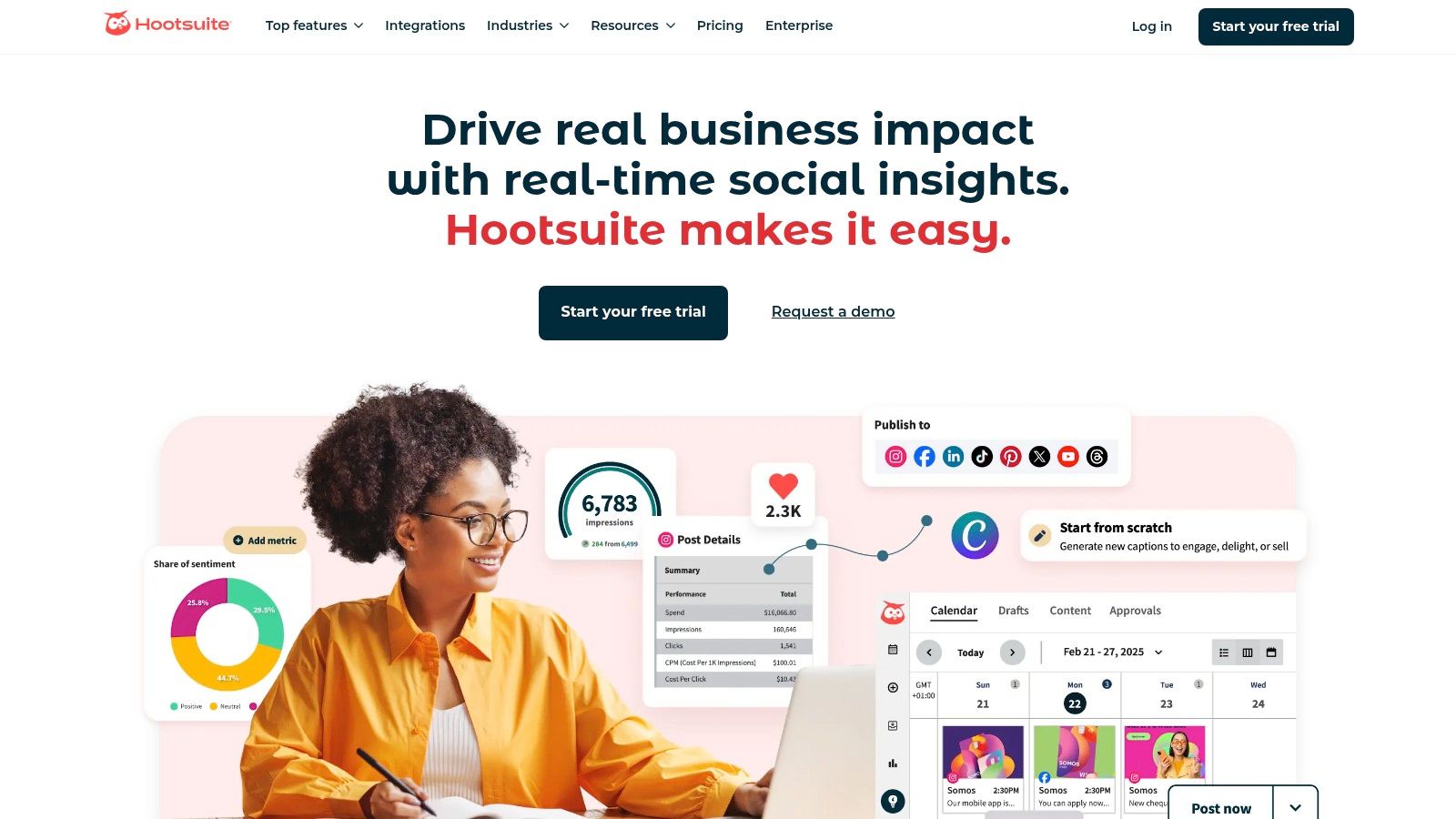
The platform is built for complex teams, with features like advanced governance, approval workflows, and a vast app directory for integrations. For developers, this means building solutions on a mature, secure, and highly scalable foundation. You can learn more about its developer offerings by exploring Hootsuite API alternatives.
Key Features & Considerations
Unlike platforms aimed at smaller teams, Hootsuite’s developer tools are designed for deep, custom integrations within a corporate environment. Access and pricing are typically handled through enterprise agreements, providing a tailored solution rather than a one-size-fits-all plan. This approach ensures robust support and security for mission-critical applications.
- API Access: Available through enterprise-level plans, often requiring a custom quote.
- Network Support: Comprehensive support for all major social networks with a focus on enterprise-grade stability.
- Documentation: Developer documentation is available but can be fragmented across different portals for its various products.
- Limitations: The high cost and complexity make it less suitable for small businesses or individual developers.
For large organizations needing a proven, secure, and feature-rich API with extensive team management and governance, Hootsuite is a leading choice.
Website:https://www.hootsuite.com
6. Agorapulse
Agorapulse offers a different angle as a SocialBu API alternative, focusing exclusively on data extraction rather than content publishing. Its Analytics Open API is designed for developers and data analysts who need to pipe social media performance metrics directly into business intelligence (BI) tools like Looker Studio or custom reporting dashboards. This makes it ideal for agencies automating client reports or in-house teams integrating social data with other business KPIs.
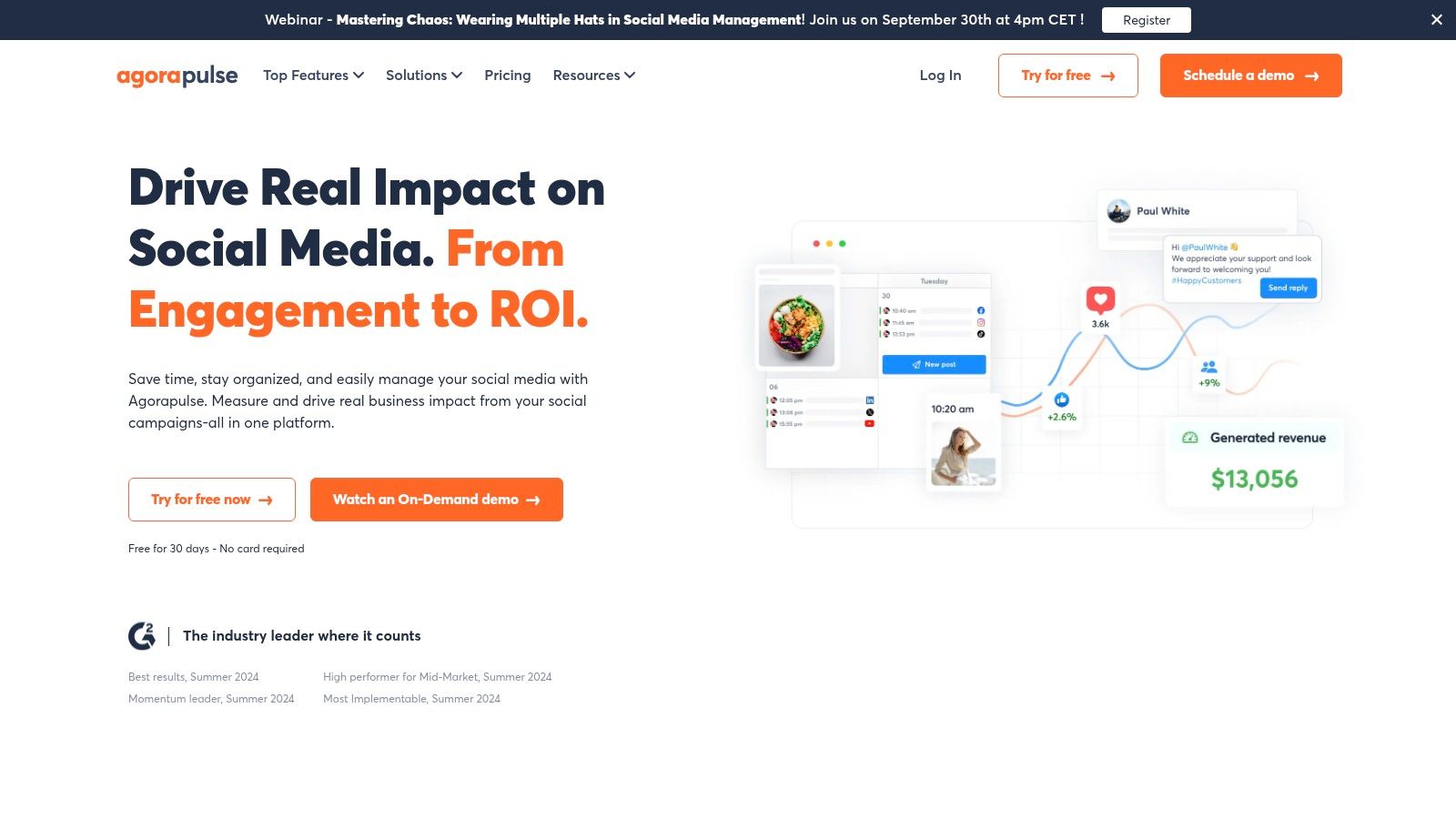
The API is strictly read-only, meaning it cannot be used to schedule posts, engage with users, or manage accounts. Instead, its strength lies in providing programmatic access to profile, content, and community metrics from major networks. With a straightforward API key generation process and a clear documentation portal, integrating it for analytics automation is a simple process.
Key Features & Considerations
Unlike platforms offering full read-write capabilities, Agorapulse positions its API as a specialized tool for reporting. API access is available on its higher-tier plans, catering to businesses that prioritize data-driven social media strategies. This clear focus simplifies its use case: if you need to pull analytics into your own systems, it's a powerful and direct solution.
- API Access: Read-only Analytics Open API included with Advanced and Custom plans.
- Network Support: Covers major social networks for analytics, though some platforms like Twitter (X) are excluded.
- Documentation: Dedicated portal with guides for retrieving profile, content, and community data.
- Limitations: The API is strictly for analytics and has no publishing or write capabilities. It has a rate limit of 500 requests per 30 minutes.
For teams whose primary automation need is centralized reporting, Agorapulse provides a robust and focused API.
Website:https://www.agorapulse.com
7. SocialPilot
SocialPilot is a cost-effective and powerful social media scheduler, particularly for agencies and large teams. For developers, it emerges as a notable SocialBu API alternative, although access is more exclusive. The platform’s API is designed for building custom integrations, automating bulk scheduling, and creating white-labeled analytics dashboards, making it ideal for enterprises that need to integrate social media workflows into their proprietary systems.
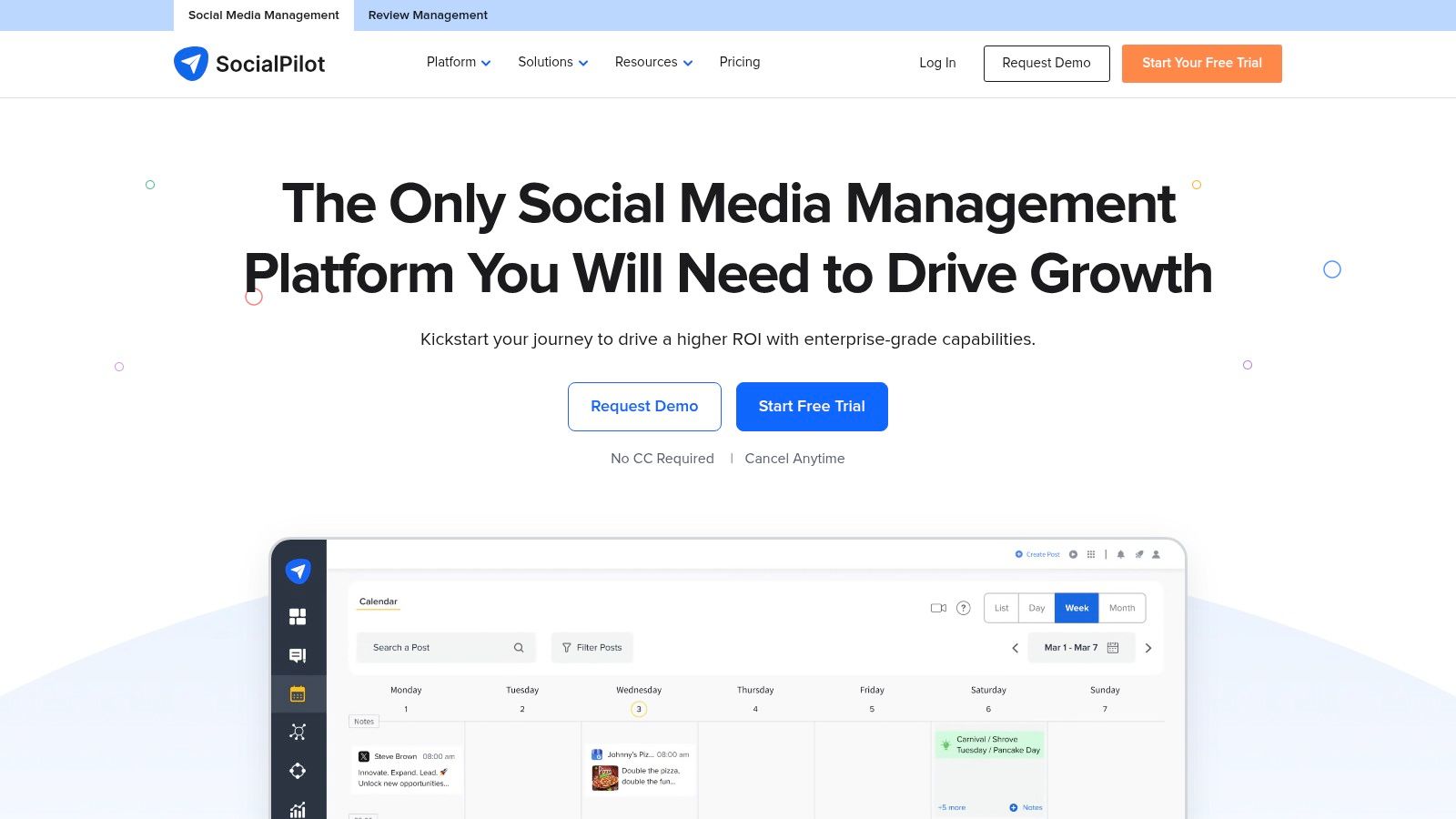
The API supports core functionalities like publishing, analytics, and account management. This allows development teams to programmatically handle client approval workflows or pull performance data into a centralized business intelligence tool, streamlining agency operations at scale.
Key Features & Considerations
Unlike platforms offering API access on mid-tier plans, SocialPilot reserves its public API for its Enterprise tier. This positions it as a solution for established organizations that can justify the investment and require features like Single Sign-On (SSO) and dedicated support. For those considering this option, exploring detailed comparisons of SocialPilot can help clarify if its enterprise focus aligns with your needs.
- API Access: Exclusively available with custom Enterprise plans.
- Network Support: Covers major platforms like Facebook, Instagram, X (Twitter), LinkedIn, Pinterest, and TikTok.
- Documentation: Provided to Enterprise customers upon request.
- Limitations: The primary drawback is the API's high barrier to entry, as it is not accessible on standard paid plans.
For large-scale agencies needing a combination of a robust UI and deep integration capabilities, SocialPilot’s enterprise offering is a strong contender.
Website:https://www.socialpilot.co
8. Later
Later is a visually-focused social media scheduler popular with creators and brands, but its API offers a unique angle for developers. While it lacks a general-purpose posting API, it provides a specialized Reporting API through its Later Influence platform. This makes it an interesting SocialBu API alternative for teams that need to programmatically pull influencer campaign data and user-generated content (UGC) metrics into custom dashboards or BI tools. It's ideal for agencies blending traditional social scheduling with robust influencer marketing analytics.
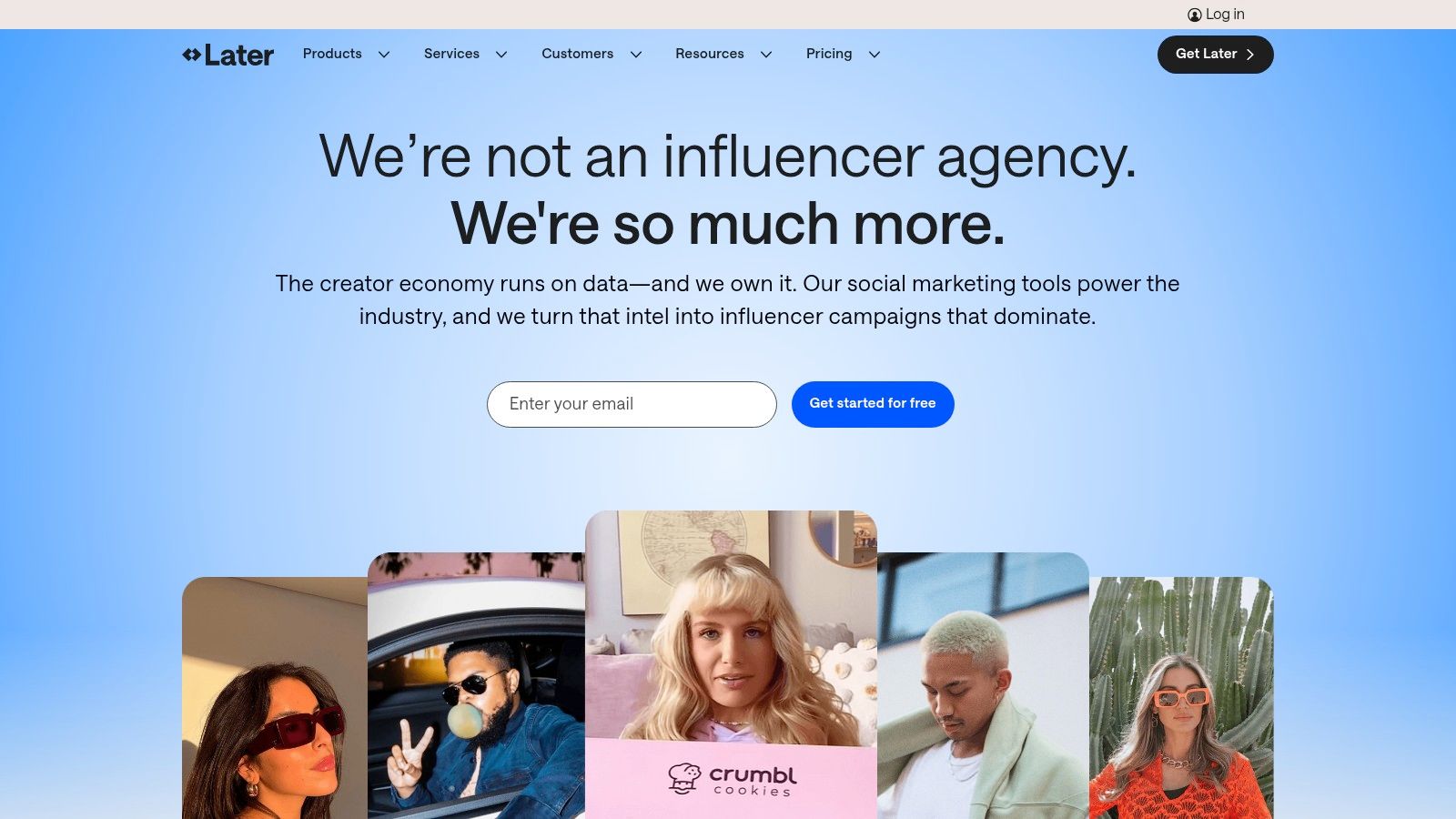
The platform excels at workflows centered around visual content, offering powerful scheduling, analytics, and link-in-bio tools. For developers, the API’s value lies in its ability to automate the reporting side of influencer collaborations, saving significant manual effort in data collection and analysis. This targeted functionality is a key differentiator from more generalized social media APIs.
Key Features & Considerations
Unlike platforms offering broad scheduling and management APIs, Later focuses its programmatic access on analytics. Access to the Reporting API is tied to the Later Influence plans, which are designed for managing and measuring influencer campaigns at scale. This positions the API as a tool for data integration rather than content automation.
- API Access: Available through Later Influence plans for reporting and analytics.
- Network Support: Strong support for Instagram, TikTok, Facebook, Pinterest, LinkedIn, and YouTube.
- Documentation: API documentation is provided to customers on relevant plans.
- Limitations: The API is specifically for reporting on influencer and UGC campaigns; it does not support programmatic post scheduling. Unlimited posting is reserved for higher-tier plans.
For development teams building custom analytics solutions for influencer marketing, Later provides a focused and powerful data source.
Website:https://later.com
9. Metricool
Metricool is a powerful all-in-one social media management tool that serves as a unique SocialBu API alternative, particularly for those focused on data integration and analytics. Instead of a traditional public REST API for direct scheduling, Metricool offers robust data pipeline solutions through its native Looker Studio (Google Data Studio) connector and comprehensive Zapier integration, available on its higher-tier plans.
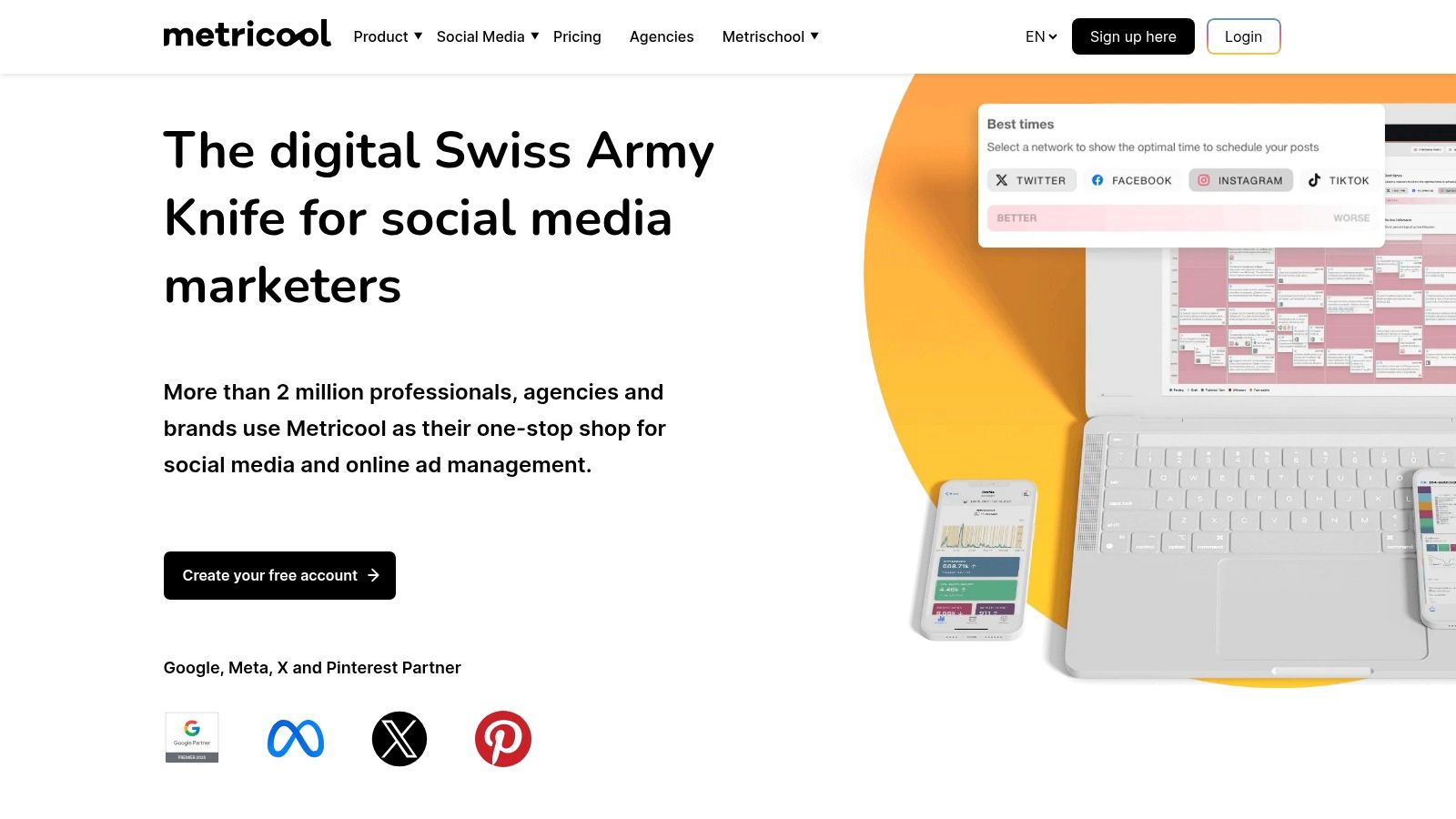
This approach is ideal for agencies and developers who need to pull social media performance data into custom dashboards or trigger complex workflows without writing proprietary code. The platform’s strength lies in its exceptional reporting and analytics features, which can be programmatically accessed through these established data connectors rather than a direct-access API.
Key Features & Considerations
While Metricool’s API is reserved for custom enterprise-level plans, its Zapier integration provides a highly capable no-code solution for automating posts and other actions. This makes it an excellent choice for teams that want to connect their social media management to a wider ecosystem of business tools. The platform also offers wide channel support, including newer networks like Threads and Bluesky.
- API Access: True API access is available only on custom Enterprise plans.
- Network Support: Extensive coverage, including Facebook, Instagram, LinkedIn, Pinterest, TikTok, Threads, and Bluesky.
- Documentation: Focuses on Zapier and Looker Studio integration guides.
- Limitations: API is not self-serve or publicly available on standard plans. Twitter (X) connections require an additional add-on fee, which can increase the overall cost.
For data-centric teams needing to integrate analytics into their BI tools, Metricool’s connector-based approach is a standout alternative.
Website:https://metricool.com
10. Make (formerly Integromat)
Make offers a different approach to being a SocialBu API alternative by focusing on visual, no-code automation rather than a traditional REST API. Developers and automators can build complex, multi-step workflows connecting social media platforms with over 2,000 other applications. It allows you to create custom logic, data transformations, and scheduled actions that mimic or even surpass what you could build with a standard API, but without writing extensive code.
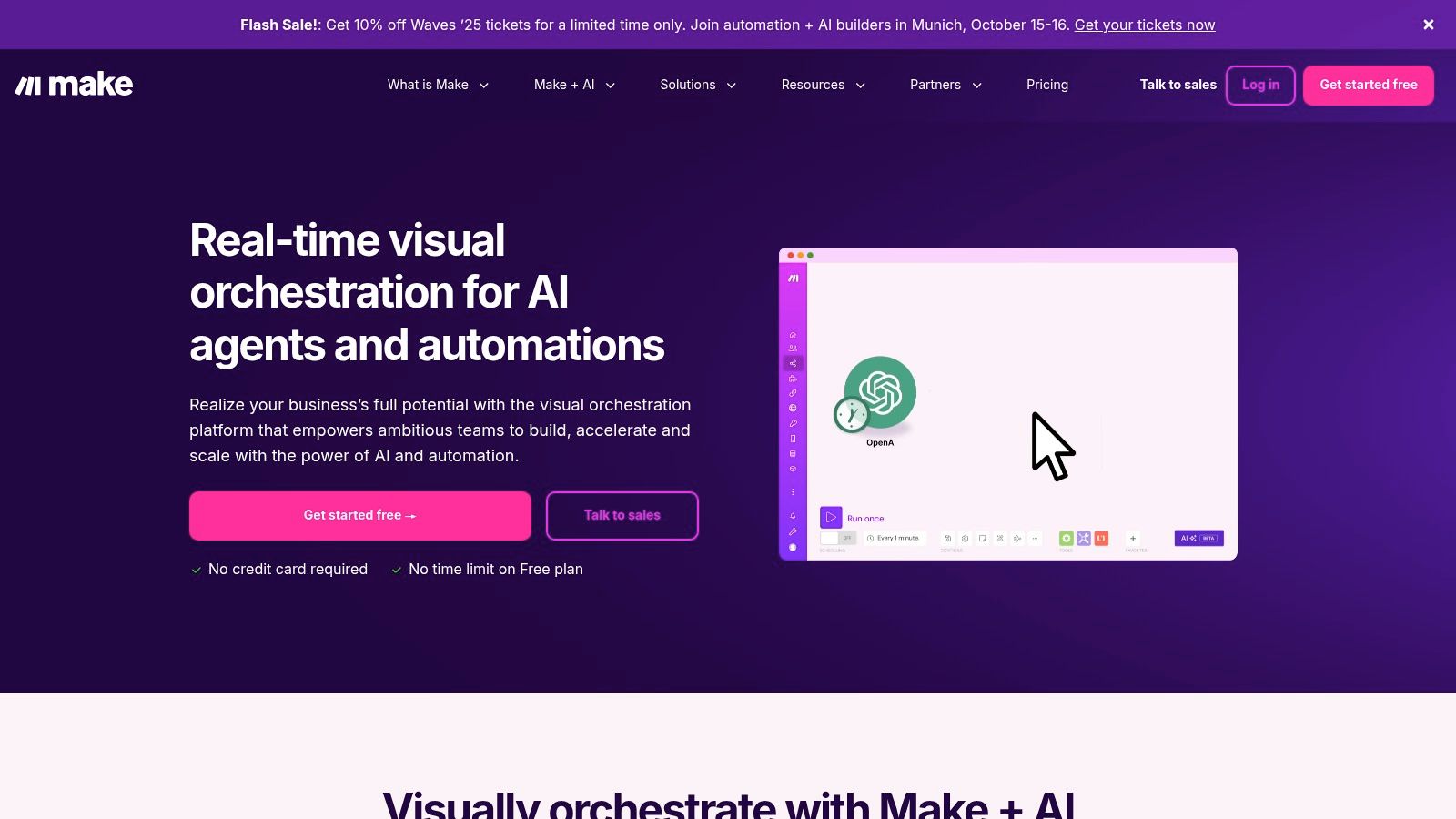
Its drag-and-drop scenario builder is incredibly powerful, enabling users to add routers for conditional logic, handle errors gracefully, and iterate over data sets. For developers, Make also supports webhooks and custom HTTP requests, providing a bridge between its visual interface and any external API you need to integrate.
Key Features & Considerations
Make’s operation-based pricing model is highly cost-effective, as you only pay for the tasks your scenarios execute. A generous free tier allows for extensive testing and small-scale automation. The platform excels at building intricate approval flows or content syndication pipelines that connect social media posts to CRMs, email marketing tools, or internal databases.
- API Access: While primarily a no-code tool, it can make HTTP requests to any API and be triggered by webhooks.
- Network Support: Connects to major platforms like Facebook, Instagram, LinkedIn, X (Twitter), Pinterest, and many others via modules.
- Documentation: Extensive tutorials, a supportive community, and detailed module guides.
- Limitations: The visual interface has a steeper learning curve for advanced scenarios, and high-volume operations require careful planning to manage costs.
For those wanting to build sophisticated social media automations without deep coding, Make is a uniquely powerful and flexible choice.
Website:https://www.make.com
11. Zapier
While not a direct API-for-API replacement, Zapier serves as a powerful no-code SocialBu API alternative for developers and teams looking to automate social media workflows without writing extensive code. It allows you to connect over 6,000 apps, including all major social platforms, creating event-driven automations ("Zaps") that can post content, update spreadsheets, or send notifications based on triggers from other services. This makes it ideal for rapid prototyping or for teams without dedicated developer resources.
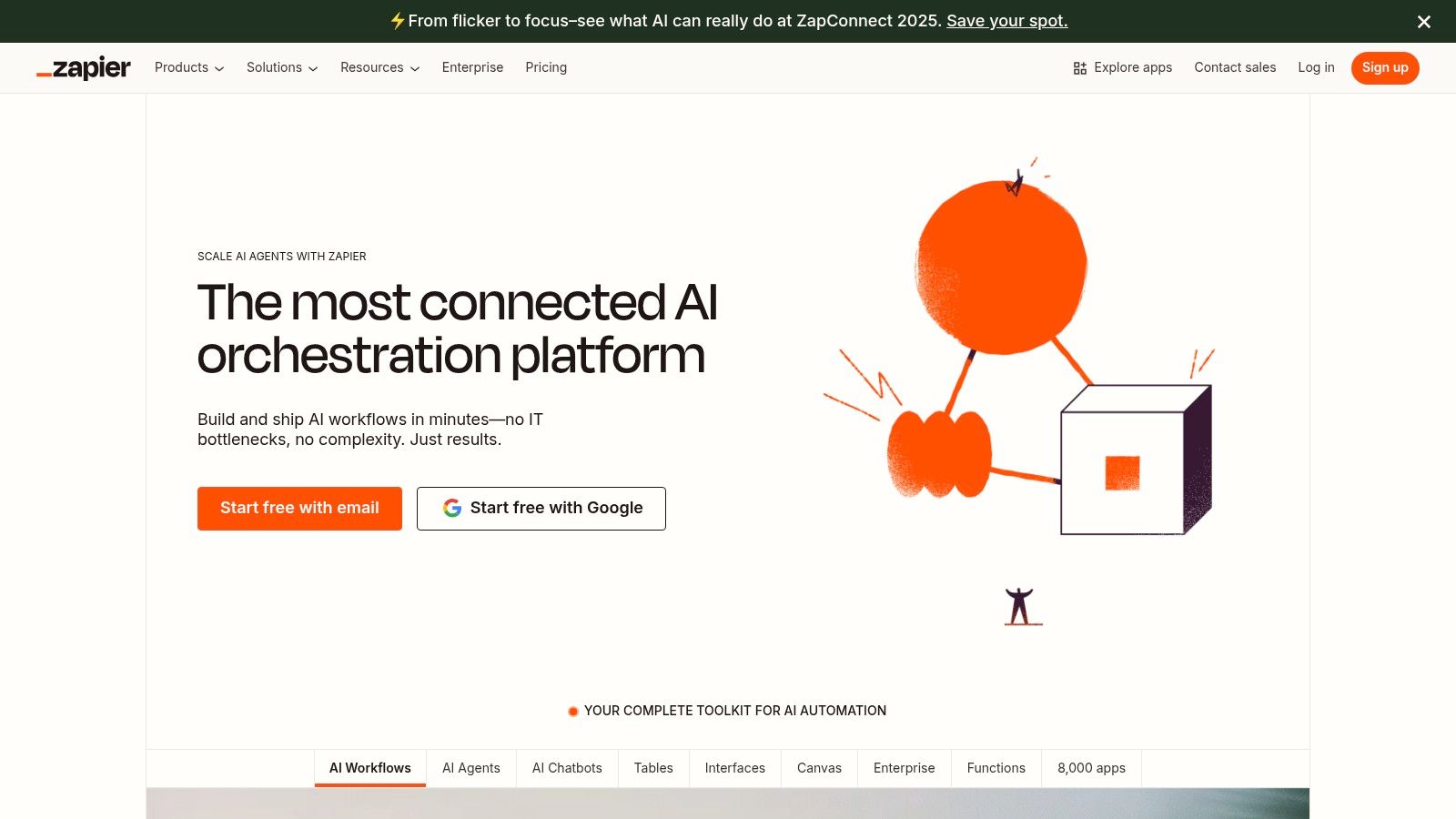
Its webhook and filter features, combined with multi-step "Paths" for conditional logic, provide a surprising degree of customization. For a deeper dive into how it fits into the automation landscape, you can learn more about its role as a leading no-code tool.
Key Features & Considerations
Zapier's strength lies in its massive integration directory and user-friendly interface, which abstracts away API complexities. However, its pricing model is task-based, meaning costs can escalate quickly with high-volume workflows compared to operation-based API pricing. Many social media integrations are also classified as "premium," requiring a paid plan to access.
- API Access: Automations are built via a no-code UI; webhooks are available for custom integrations.
- Network Support: Extensive, covering virtually every major social media platform through its 6,000+ app integrations.
- Documentation: Comprehensive help center and guides for building Zaps with every connected app.
- Limitations: Can become expensive at scale, and complex, multi-step Zaps with conditional logic are gated behind higher-tier plans.
For fast deployment and connecting disparate systems without code, Zapier is an unparalleled automation engine.
Website:https://zapier.com
12. Pabbly Connect
Pabbly Connect offers a unique value proposition as a SocialBu API alternative, focusing on no-code automation with a highly attractive pricing model. Instead of a traditional API, it uses webhooks and a visual workflow builder to connect apps, allowing developers and non-developers alike to create automated social media posting sequences without writing code. This makes it ideal for users who need to link social platforms to other tools like CRMs, forms, or RSS feeds.
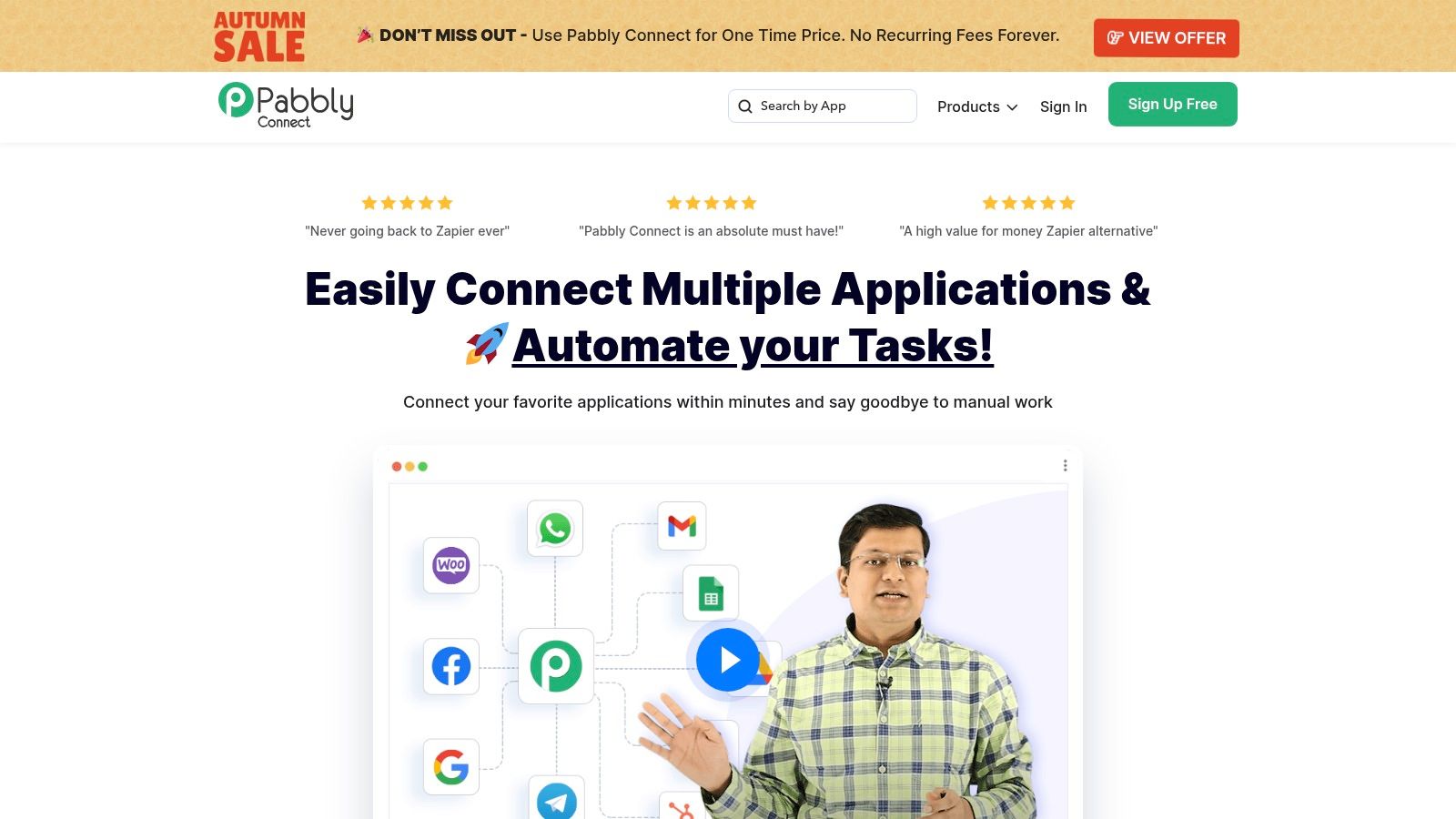
Its biggest differentiator is its lifetime deal structure, where a one-time payment grants a generous number of monthly tasks. This is a game-changer for those looking to escape the recurring subscription fees common with other automation platforms.
Key Features & Considerations
Unlike API-first platforms, Pabbly Connect's power lies in its simplicity and vast integration library. You can easily set up multi-step workflows, such as automatically posting a new blog entry to Facebook, Twitter, and LinkedIn simultaneously. The platform includes over 900 pre-built templates to accelerate setup.
- API Access: Achieved through webhooks and an extensive library of app integrations.
- Network Support: Connects to major platforms like Facebook, Twitter, LinkedIn, Telegram, and Pinterest via its app connectors.
- Pricing Model: Offers one-time payment plans for lifetime access, with different tiers based on monthly task allowances.
- Limitations: The ecosystem of integrated apps is smaller than giants like Zapier. Monthly task limits still apply and upgrading between lifetime deal tiers can be restricted after initial purchase.
For users prioritizing cost-effectiveness and no-code simplicity over a direct REST API, Pabbly Connect is an incredibly compelling choice.
Website:https://www.pabbly.com/connect/
SocialBu API Alternatives Feature Comparison
| Product | Core Features & Platform Coverage ✨ | User Experience & Reliability ★ | Value & Pricing 💰 | Target Audience 👥 | Unique Selling Points 🏆 |
|---|---|---|---|---|---|
| LATE 🏆 | Unified API for 10+ platforms; REST endpoints; no-code tools (Zapier, n8n, Make) | 99.97% uptime; sub-50ms response; quick setup <15min | Free to Enterprise plans; tiered & cost-effective | Developers, agencies, social managers, no-code enthusiasts | Multi-client management; team collaboration; white-label options |
| Publer | REST API for posts/media/analytics; broad platform support | Clear docs; easy token mgmt | API only on Business+ tiers; daily post limits | SMEs, marketers needing API access | Wide channel coverage; bulk scheduling |
| Sprout Social | Public API for analytics & publishing; OAuth 2.0; admin-gated access | Robust analytics & enterprise security | API on Advanced plans only | Enterprises, BI teams | Enterprise-grade security & governance |
| Buffer | OAuth 2.0 API for profiles, schedules; Zapier integration | Familiar UI; clear API limits | Affordable plans; nonprofit discounts | SMBs, creators | Simple programmatic posting |
| Hootsuite | Extensive APIs/SDKs; CRM & messaging integrations | Mature ecosystem; enterprise-grade support | Pricing varies; quote-based | Large organizations | Broad team & workflow features |
| Agorapulse | Read-only Analytics API; major socials except Twitter | Simple integration; clear API limits | Analytics-only API | Analytics-focused teams | Centralized BI reporting |
| SocialPilot | Bulk scheduling; white-label reporting; API on Enterprise tier | Scalable with multi-user support | API limited to Enterprise; add-on pricing | Agencies, enterprises | Unlimited users on top plan |
| Later | Scheduler + Reporting API for influencer campaigns | Strong creator focus; influencer analytics | Post caps vary; unlimited posts on higher tiers | Creators, brands | Influencer campaign reporting |
| Metricool | Planner, analytics, Looker Studio connector; Zapier integration | Strong reporting; modest pricing | API on custom plans only | Data-driven marketers | AI assistant; broad channel support |
| Make | No-code automation; drag-drop builder; webhooks | Cost-efficient; flexible workflows | Operation-based pricing | No-code builders, automation experts | Complex workflow branching |
| Zapier | 6000+ apps; webhooks; conditional logic | Massive app directory; enterprise governance | Pay-per-task model; can be costly at scale | Rapid prototypers, non-developers | Fast deployment; extensive integrations |
| Pabbly Connect | No-code automation; one-time payment tiers; webhook support | Predictable pricing; task limits | Lifetime plans with monthly task caps | Cost-conscious automators | Lifetime pricing; large template library |
Choosing the Right Social Media Automation Engine
Navigating the landscape of social media automation tools can feel complex, but this deep dive into the top SocialBu API alternative options reveals a clear path forward. The "best" solution is not a one-size-fits-all answer; it's the one that aligns perfectly with your technical requirements, team workflow, and strategic goals. We've explored a diverse range of powerful platforms, from developer-first unified APIs to comprehensive social media management suites and versatile no-code connectors.
Your final decision hinges on identifying your primary objective. Are you a developer aiming to build a scalable, high-performance application? Then a dedicated, unified API like LATE or the robust offerings from Publer should be at the top of your list. These tools are engineered for programmatic control and efficiency, providing the foundational infrastructure you need without the overhead of a full-blown SMM user interface.
Key Factors for Your Final Decision
As you evaluate your options, consider these critical decision-making factors to select the ideal SocialBu API alternative for your project:
- Primary Use Case: Is your main goal content publishing, deep analytics, inbox management, or a combination of all three? Sprout Social and Agorapulse excel at analytics and reporting, while Buffer and Later are streamlined for publishing workflows. Define your core need first.
- Technical Proficiency: If you're building with code, assess the quality of the API documentation, the availability of SDKs, and the responsiveness of developer support. For no-code or low-code teams, the intuitive visual builders of Make, Zapier, or Pabbly Connect offer unparalleled flexibility without requiring deep programming knowledge.
- Scalability and Rate Limits: Consider your future growth. A solution with generous rate limits and a predictable pricing model, like that offered by SocialPilot or LATE, will prevent unexpected roadblocks as your usage increases. Scrutinize the API documentation for any limitations that could impact your application's performance.
- Breadth of Platform Support: Ensure your chosen tool supports all the social networks vital to your strategy. While most cover the major platforms, niche network support (like Pinterest, TikTok, or Google Business Profile) varies significantly between providers like Metricool and Hootsuite.
Moving Forward with Confidence
The journey from selection to implementation is the final, crucial step. Begin by mapping out your desired workflow, whether it’s a custom content approval system or an automated "post from RSS" integration. Leverage the free trials and sandbox environments offered by most of these platforms to build a proof-of-concept. This hands-on testing is invaluable for confirming that your chosen SocialBu API alternative not only meets your feature requirements but also provides a developer experience that accelerates, rather than hinders, your progress. By carefully weighing your specific needs against the distinct strengths of each tool, you can confidently integrate a powerful automation engine that will elevate your social media strategy to new heights.
Ready to build powerful social media integrations without the complexity? LATE provides a single, unified API for all major platforms, designed specifically for developers seeking a reliable and scalable SocialBu API alternative. Explore our comprehensive documentation and start building for free at LATE.